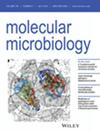PorA of the Type IX Secretion Is a Ligand of the PorXY Two-Component Regulatory System in Porphyromonas gingivalis
IF 2.6
2区 生物学
Q3 BIOCHEMISTRY & MOLECULAR BIOLOGY
引用次数: 0
Abstract
Porphyromonas gingivalis is an important bacterium associated with chronic periodontitis. The type IX secretion system (T9SS) in P. gingivalis secretes conserved C-terminal domain (CTD) containing proteins, which are also called T9SS cargo proteins, including gingipain proteinases, to the cell surface and extracellular milieu. We have shown that gene expression of some T9SS component proteins is regulated by a two-component regulatory system, PorX-PorY, an ECF sigma factor, SigP, and a T9SS cargo protein, PorA. As PorA has its own CTD, PorA is mainly localized as an A-LPS-bound form and PorV-bound form on the cell surface. However, it remains unclear how PorA can activate the PorXY-SigP signaling cascade. In this study, our results revealed that the CTD of PorA can activate the PorXY-SigP signaling cascade via interaction with PorY. It is well known that the canonical role of CTD is to act as a secretion signal for T9SS protein export. In here, we propose a novel concept that the CTD of PorA can play a dual role: as a secretion signal directing the secretion of PorA and as a positive regulator of T9SS gene expression by binding to PorY in the periplasm.

牙龈卟啉单胞菌IX型分泌的PorA是PorXY双组分调控系统的配体
牙龈卟啉单胞菌是一种与慢性牙周炎相关的重要细菌。牙龈卟啉单胞菌的九型分泌系统(T9SS)向细胞表面和细胞外环境分泌含有保守的 C-末端结构域(CTD)的蛋白,这些蛋白也被称为 T9SS 货物蛋白,包括牙龈蛋白酶。我们的研究表明,一些 T9SS 组成蛋白的基因表达受双组分调控系统 PorX-PorY、ECF 西格玛因子 SigP 和 T9SS 货物蛋白 PorA 的调控。由于 PorA 有自己的 CTD,因此 PorA 主要以 A-LPS 结合型和 PorV 结合型的形式定位于细胞表面。然而,目前仍不清楚 PorA 如何激活 PorXY-SigP 信号级联。本研究的结果显示,PorA 的 CTD 可通过与 PorY 的相互作用激活 PorXY-SigP 信号级联。众所周知,CTD 的典型作用是作为 T9SS 蛋白质输出的分泌信号。在本文中,我们提出了一个新的概念,即 PorA 的 CTD 可以发挥双重作用:作为分泌信号指导 PorA 的分泌,以及通过与外质中的 PorY 结合成为 T9SS 基因表达的正向调节因子。
本文章由计算机程序翻译,如有差异,请以英文原文为准。
求助全文
约1分钟内获得全文
求助全文
来源期刊

Molecular Microbiology
生物-生化与分子生物学
CiteScore
7.20
自引率
5.60%
发文量
132
审稿时长
1.7 months
期刊介绍:
Molecular Microbiology, the leading primary journal in the microbial sciences, publishes molecular studies of Bacteria, Archaea, eukaryotic microorganisms, and their viruses.
Research papers should lead to a deeper understanding of the molecular principles underlying basic physiological processes or mechanisms. Appropriate topics include gene expression and regulation, pathogenicity and virulence, physiology and metabolism, synthesis of macromolecules (proteins, nucleic acids, lipids, polysaccharides, etc), cell biology and subcellular organization, membrane biogenesis and function, traffic and transport, cell-cell communication and signalling pathways, evolution and gene transfer. Articles focused on host responses (cellular or immunological) to pathogens or on microbial ecology should be directed to our sister journals Cellular Microbiology and Environmental Microbiology, respectively.
 求助内容:
求助内容: 应助结果提醒方式:
应助结果提醒方式:


